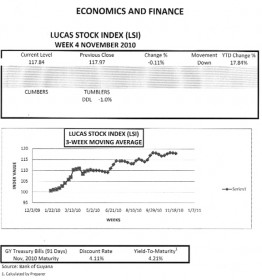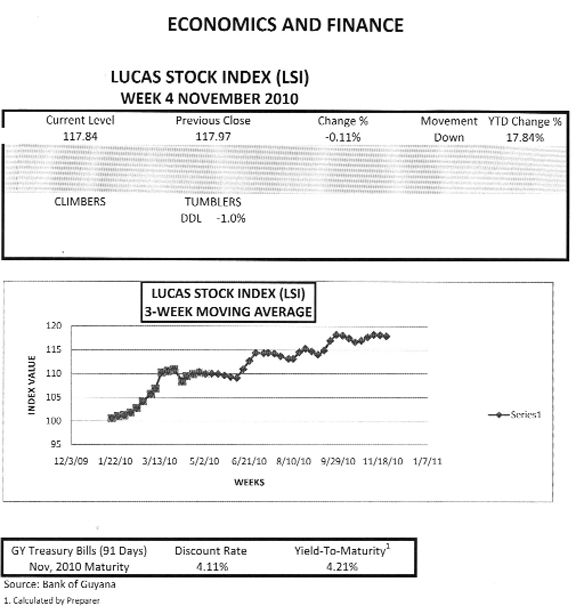Benefit
The rank of 104 would have looked much different if the architects of the 2010 Human Development Index (HDI) had kept the population of countries from its previous reports. The exclusion of the Caribbean countries of Antigua and Barbuda, Dominica, Grenada, Saint Kitts and Nevis, Saint Lucia and Saint Vincent and the Grenadines made way for Guyana to move up the ranks instead of occupying the 110th spot. According to the authors of the report, these countries were removed from coverage because of the unavailability of data or the uncertainty of validity of their data. The removal from the report must have been a shock to Antigua and Barbuda which, along with Barbados, was listed among the countries with a very high human development. The absence of these six Caribbean countries from the report turned out to be a blessing in disguise for Guyana, allowing it to move to a more favourable position in the ranking. Even with that, the value of the index improved for Guyana leading consumers of the report to believe that it has made progress in some area or areas of importance.
Caution
The authors of the Human Development (HDR) were careful also to caution users about using the indices to compare the quality of life across countries. Even though they say that, it would be hard not to notice that, despite the progress Guyana has shown, it has fallen quickly behind several countries that it superseded only a few years ago. Countries like Jamaica, Algeria, Azerbaijan, El Salvador, Sri Lanka, Gabon and Bolivia had lower rankings than Guyana two years ago but have risen to better placement in the 2010 report that was released earlier this month. In a few cases, the rise in ranking is meteoric. Azerbaijan, for example, rose 31 places from a rank of 98 two years ago to a rank of 67. Similarly, Gabon rose 26 places to 93 to achieve a rank above Guyana. The new placement of countries like Bolivia, Turkmenistan, Algeria and Jamaica are also eye-catching since the first two countries moved 22 places while Jamaica and Algeria moved 21 and 20 positions respectively.
Anomaly

LUCAS STOCK INDEX
In week four of November 2010, the Lucas Stock Index (LSI) showed declined by 0.1 percent from the previous week. The index ended the period at 117.94 after experiencing no change last week and after reaching 118.49 during the first week of the month. Trading this week saw the stocks of DDL decline by 1 percent. Notwithstanding the decline, the index remains above four times that of the risk-free Treasuries with maturity in November 2010.
There is no doubt that Guyanese are wondering how it is that countries could exhibit such notable changes in rank and Guyana for all the money it is spending has been unable to sustain any kind of consistent upward movement in rank. A review of some data points might provide some insight to the anomaly and why the authors preach against using it for international comparison. Life expectancy in Algeria and Bolivia for example increased by 1.2 and 1.6 years respectively while in Guyana it improved by 2.7 years, almost a doubling of both countries. At the same time, the mean schooling in Algeria is 7.2 years while in Guyana it is 8.2 years. Yet, Algeria was able to vault 20 spots from 104 to 84 in the 2010 report. These meaningful disparities offer no
rationale for Guyana’s placement, especially when it is noticed that the inequality index in Guyana is 39.7 while it is 45.5 in Gabon and 48.3 in Bolivia. Yet, Guyana trails these countries.
More Data
Part of this anomaly has to do with the handling of data and nothing to do with the impact of current policy changes. It must be kept in mind that two things often happen when the HDR is being prepared. One point of relevance is that the period that the data cover can change. In the 2008 report, the preparers of the index point out that estimates have been based on data covering the period 1975 to 2005. The authors of these reports have explained that historical data that are already in the possession of international agencies which are often used in the preparation of the index could be revised and this revision could result in the change in the rank of a country. A second reason for the change in ranking between Guyana and other countries could be as a result of changes in country coverage. Simply put, the index could be using more data than it had in the past not necessarily for Guyana, but for the countries that have shown rapid improvements.
Lingering Problems
Considering that some of the data used in the preparation of the index could be from as far back as the early nineties, the index does not necessarily tell us all that we need to know about what is happening in Guyana today. As the authors of earlier Human Development Reports confirm, these reports often reflect revision of historical data rather than “real changes in a country”. From that perspective, the index best represents an indication of lingering social and economic problems and really do not reflect the impact of new problems and the effectiveness of current public policy on tackling those problems for the well being of Guyanese households. One way to understand this situation is to examine the relationship between household income and household spending in the aggregate between 1992 and 2009.
Scrambling
The information is presented in current prices and is addressing spending and not necessarily consumption levels. From 1992 to 2004, Guyanese had an estimated annual average of G$13.5 billion left after using their disposable income to meet household needs. By 2009, that situation had changed dramatically. From 2005 to 2009, Guyanese households have been scrambling around to find as much as G$42 billion each year to make ends meet. The spending refers to Guyanese of all income levels. This means that the numbers refer to the wealthy who could afford to buy a lot of highly expensive items and to the poor and not-so-poor who are probably going hungry or living on the margins. The preparers of the HDI are working to bring data on households current but it is clear that the UN data is still to catch up with the realities in Guyana. At some point, the impact of the floods of 2005 and 2006 and the punitively high rate of VAT introduced in 2007 would soon catch up with Guyana.
Believe
It is against this background that the 2010 HDR should be viewed. Guyanese have to believe that the administration is interested in seeing improvements in the living standards of the country, but must also wonder if they are going about it the right way. The administration has a guide, the Millennium Development Goals (MDG) to help it. The index focuses on three components of those goals, income, education and health in an effort to tackle the problems of poverty. Yet, the concern over the handling of the economy is not over blown because the HDR indicates that the very high inequality in income is responsible for the largest reduction in the HDI by countries of the region to which Guyana belongs.





